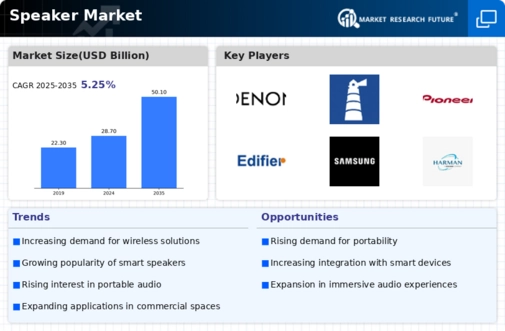Top Industry Leaders in the Speaker Market

Competitive Landscape of the Speaker Market
The speaker market, encompassing both traditional and smart speakers, pulsates with dynamic competition. Established brands battle it out with agile newcomers, each vying for a slice of the audiophile's pie. Understanding this landscape requires dissecting the strategies adopted, analyzing market share factors, and identifying rising stars. So, let's crank up the volume and explore the competitive scene.
Key Players:
- Sony Corporation
- JBL
- Harman Kardon
- Polk Audio
- Ultimate Ears
- Marshall
- Edifier
- Krell
- Devialet
- Focal
- Bowers & Wilkins
- Yamaha Corporation
- Pioneer Electronics
- LG Electronics
- Samsung Electronics
- Sennheiser
- Klipsch
- Bang & Olufsen
- Sonos
- Teufel
- Naim Audio
- Cambridge Audio
Strategies Adopted by Key Players:
-
Tech Innovation: Leading players like Sony, Bose, and Sonos invest heavily in R&D, churning out speakers with superior sound quality, advanced features like multi-room audio, and seamless connectivity. This focus on cutting-edge technology helps them retain their premium positioning. -
Ecosystem Expansion: Tech giants like Amazon and Google leverage their existing ecosystems (Alexa and Assistant, respectively) to offer smart speakers at competitive prices. This strategy fosters user loyalty and creates a sticky ecosystem where speakers seamlessly integrate with other smart home devices. -
Targeted Marketing: Brands like Ultimate Ears and JBL cater to specific demographics, like adventure enthusiasts or partygoers, with ruggedized speakers and powerful sound profiles. This targeted approach allows them to carve out niche markets and build dedicated brand communities. -
Direct-to-Consumer (DTC) Approach: New players like Anker and Tribit bypass traditional retail channels, selling directly to consumers online. This strategy reduces costs and allows for quicker product iteration, giving them an edge in the fast-paced market.
Market Share Analysis:
-
Brand Recognition: Established names like Bose and Sonos command significant brand loyalty, translating into higher market share despite often premium pricing. -
Value Proposition: Budget-friendly brands like JBL and Sony's Extra Bass series cater to price-conscious consumers, capturing a larger market segment. -
Feature Differentiation: High-end audiophile brands like Bowers & Wilkins and KEF focus on superior sound quality and craftsmanship, attracting audio enthusiasts willing to pay a premium. -
Smart Home Integration: Amazon and Google dominate the smart speaker market due to their integrated ecosystems and voice assistants, making them natural choices for smart home enthusiasts.
New and Emerging Players:
-
AI-Powered Audio: Companies like Lyre AI and Klipsch are incorporating AI into their speakers, offering personalized sound profiles and adaptive audio experiences. -
Sustainable Materials: Brands like House of Marley and Ecologic Audio use sustainable materials like bamboo and recycled plastics, appealing to environmentally conscious consumers. -
Modular Design: Companies like Snapmaker and Block are exploring modular speaker designs, allowing users to customize and upgrade their audio systems over time. -
Immersive Audio: Brands like Razer and Creative Labs are pushing the boundaries of immersive audio with surround sound systems and haptic feedback features, catering to gamers and movie enthusiasts.
Industry Developments
Sony:
-
Spatial Audio Technologies: Sony has been a leader in developing and implementing spatial audio technologies, like Dolby Atmos and 360 Reality Audio. They recently announced updates to their soundbar lineup, including the HT-A7000 and HT-A5000, which boast improved spatial audio performance and support for Dolby Atmos and DTS:X. -
Wireless Multi-room Speakers: Sony's expanding its range of wireless multi-room speakers with the addition of the LinkBuds S and LinkBuds WF. These earbuds offer a unique open-ear design for ambient awareness and spatial audio experiences. -
Focus on Sustainability: Sony is incorporating sustainable practices into its speaker production, using recycled materials and reducing packaging waste.
JBL:
-
Portable Smart Speakers: JBL continues to focus on the portable smart speaker market with new models like the JBL Flip 6 and JBL Pulse 5. These speakers offer improved sound quality, longer battery life, and water resistance. -
Gaming Speakers: JBL is targeting gamers with the Quantum Gaming Headset series, which offers immersive surround sound and clear communication features. -
Collaboration with Esports Teams: JBL has partnered with several esports teams and organizations, further solidifying its presence in the gaming audio market.
Additional Industry Developments:
-
Growing Demand for Smart Speakers: The smart speaker market is expected to continue growing rapidly, driven by increasing adoption of voice assistants and connected homes. -
Focus on Personalized Audio: Speaker manufacturers are increasingly focusing on personalization features, such as adjustable EQ and sound profiles. -
Rise of Wireless Technologies: Wireless technologies like Bluetooth and Wi-Fi are making speakers more portable and versatile.
